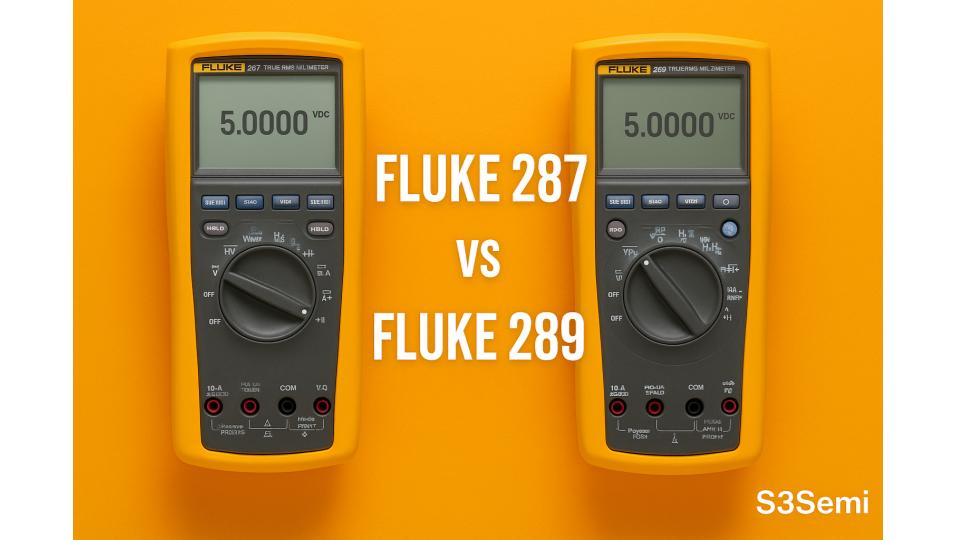When it comes to advanced digital multimeters, the Fluke 287 and Fluke 289 are two of the most popular high-performance models. Both are part of Fluke’s logging multimeter series, designed for engineers, technicians, and professionals who need precision, data logging, and advanced troubleshooting capabilities.
🏷️ Fluke Multimeter Deals ⭐⭐⭐⭐
While they share many similarities, some differences may determine which one is right for you.
🔍 Overview of the Fluke 287
The Fluke 287 is a high-resolution True RMS logging multimeter. It’s built for advanced electronics and industrial troubleshooting, where accuracy and data recording are critical.
Key Features:
- True RMS for accurate readings on non-linear loads
- Large, high-resolution dot-matrix display with TrendCapture™
- Data logging with on-screen graphing
- Measures AC/DC voltage, current, resistance, frequency, capacitance, and duty cycle
- 50,000-count display (digitally enhanced up to 500,000 counts)
- Min/Max/Average and Peak Min/Max capture
- USB interface for PC connectivity
- CAT IV 600V / CAT III 1000V safety rating
Best For: Engineers and electronics professionals who need high-accuracy readings and advanced logging for troubleshooting and documentation.
⚡ Overview of the Fluke 289
The Fluke 289 builds on the capabilities of the 287 and is often considered the flagship handheld logging multimeter. It includes all the features of the 287, with a few extra enhancements aimed at demanding industrial environments.
Key Features:
- Everything the Fluke 287 offers, plus:
- More robust data logging with expanded memory
- Logging up to 15,000 recorded events
- Enhanced TrendCapture™ with higher detail
- Low-pass filter (LPF) for accurate measurements on variable frequency drives (VFDs)
- Additional measurement functions for complex industrial systems
- Backlit display with multiple information views
Best For: Industrial technicians, plant maintenance, and professionals dealing with complex machinery or environments requiring detailed long-term logging.
📊 Side-by-Side Comparison Table
| Feature | Fluke 287 | Fluke 289 |
|---|---|---|
| True RMS | ✅ Yes | ✅ Yes |
| Display | High-resolution, TrendCapture | High-resolution, TrendCapture (enhanced) |
| Data Logging | Standard with TrendCapture | Expanded with higher memory |
| Logging Capacity | Thousands of records | Up to 15,000 events |
| VFD/Low-Pass Filter | ❌ No | ✅ Yes |
| Connectivity | USB PC interface | USB PC interface |
| Safety Rating | CAT IV 600V / CAT III 1000V | CAT IV 600V / CAT III 1000V |
| Best For | Electronics troubleshooting | Industrial environments with VFDs and heavy machinery |
| 💳 Pricing | 💲 Check Price | 💲 Check Price |
✅ Pros and Cons of Each
Fluke 287 Pros:
- High accuracy with True RMS
- TrendCapture™ makes logged data easy to review on-screen
- Excellent for electronics troubleshooting
- Slightly more affordable than the 289
Fluke 287 Cons:
- Lower memory capacity for logging
- No low-pass filter for VFD measurements
Fluke 289 Pros:
- Expanded logging memory
- Enhanced TrendCapture™ for detailed analysis
- Low-pass filter for VFDs and industrial applications
- Superior data handling for long-term monitoring
Fluke 289 Cons:
- More expensive than the 287
- Bulkier for field use
🏆 Verdict: Fluke 287 or Fluke 289?
Both the Fluke 287 and Fluke 289 are advanced logging multimeters built for professionals who need more than just standard measurements.
- Choose the Fluke 287 if you are primarily working with electronics, R&D, or general troubleshooting where high accuracy and solid data logging are essential.
- Choose the Fluke 289 if you are in an industrial environment, need to log large amounts of data, or work with variable frequency drives that require a low-pass filter.
👉 In short:
- Fluke 287 = High-accuracy troubleshooting multimeter for electronics.
- Fluke 289 = Industrial-grade logging multimeter with expanded features.



